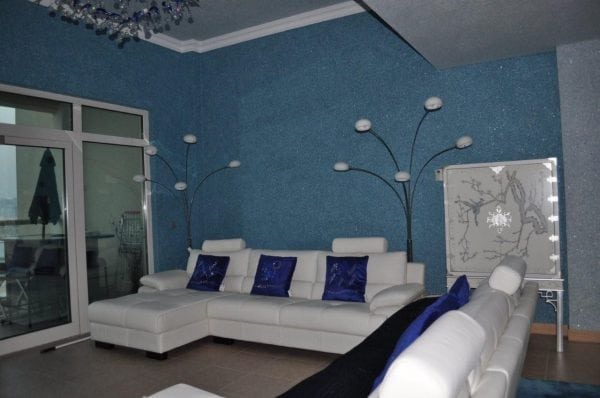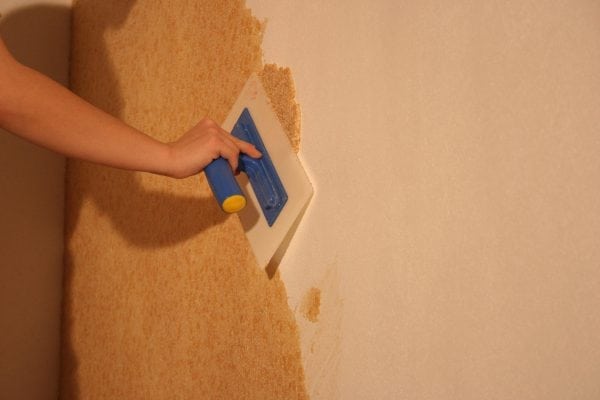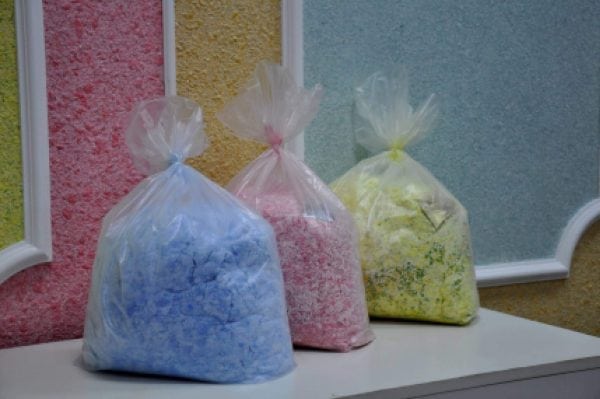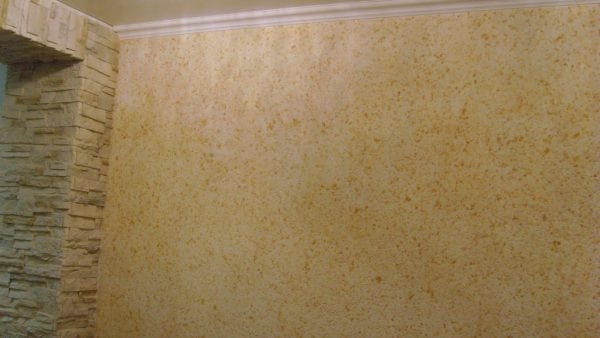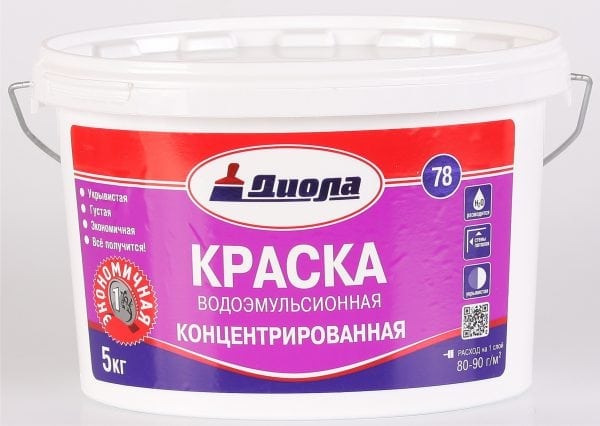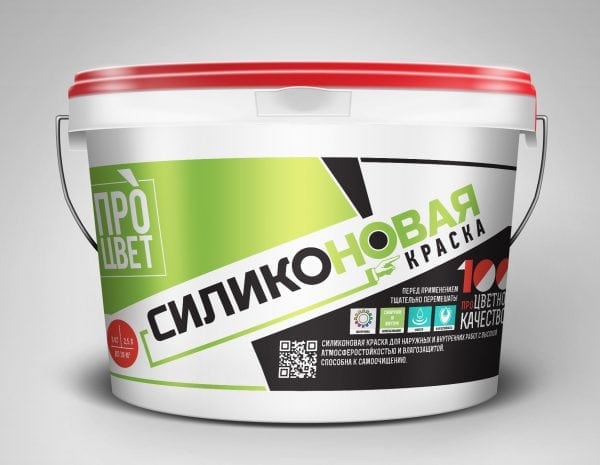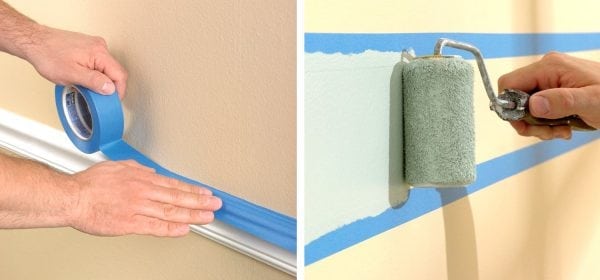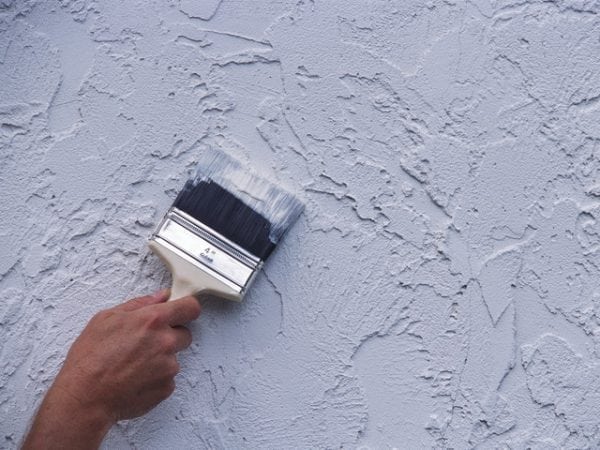Liquid wallpaper is a popular material for decorative decoration. However, over time, any interior for various reasons loses relevance. You can completely replace it, but you can modify it.
- Features of liquid wallpaper
- Why paint the wallpaper
- Advantages and disadvantages of staining
- Varieties of colors
- Water based paints
- Acrylic paints
- Latex
- Silicone
- Lacquer
- Wall preparation
- Painting
- Features of the application of patterns and drawings
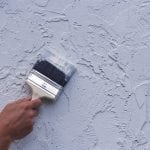
In the case of wallpaper we are talking about painting. Paint for liquid wallpaper is an excellent option for updating the appearance of the walls while maintaining the integrity of the base.
Features of liquid wallpaper
A powder mixture - liquid wallpaper - includes such components:
- crushed oak bark;
- cotton fragments;
- mica;
- silk;
- dried seaweed.
Due to the presence of silk, the material acquires a special texture. The external effect is provided by the addition of golden and silver threads, special sparkles. Decorative coatings resemble a stone or a very dense felt surface.
Liquid wallpaper for painting is used to decorate only the internal parts of buildings. Such coatings are safe from a fire and environmental point of view. No wonder they are recommended for use in children's rooms and bedrooms. The material is ideal for decorating living rooms, hallways, public spaces.
Three varieties of liquid wallpaper are known:
- Silk. Inside this finishing material there is an increased proportion of natural silk.
- Cotton They contain 98% cotton fiber and 2% other impurities, including mica, cellulose, and decorative elements. To the touch, this material is soft and warm.
- Cellulose. As a basis, a wood processing product is used - cellulose. Wallpaper of this type is used in cold unheated rooms. The mixture is excellent for surfaces with microcracks.
The material is available in two variations:
- Ready to use composition. Simply put on the wall.
- Powdered mass of white color. The master independently makes the solution, adding the necessary dyes and decorative components to the base.
Why paint the wallpaper
There are several considerations that affect the need for painting:
- The formation of multiple stains and stains on the wall. If they cannot be completely cleaned, it is easiest to hide flaws behind a layer of paint.
- Over time, the old color may bother or cease to be relevant (fashionable). New paint will refresh the interior.
- A layer of paint will give the material extra protection and extend its life.
Advantages and disadvantages of staining
Among the advantages that staining liquid wallpaper provides, we can distinguish:
- Painting allows you to qualitatively mask the defects existing on the coating. However, if there are oil stains, they must be degreased in advance, since otherwise it will not be possible to achieve good adhesion (adhesion of dissimilar materials to each other).
- Painting is a way to radically change the appearance of a room.
- You can repaint the walls an unlimited number of times.
- There is a wide variety of colors and shades of paints.
- Do-it-yourself staining is available to anyone, even a layman.
- The components of the composition are environmentally friendly, lack of allergens.
- The material passes oxygen, which allows the walls to "breathe". This ensures a normal microclimate in the room and a normal state of the base from which the walls are made.
Cons of staining liquid wallpaper:
- Applying paint to liquid wallpaper changes the surface structure. The material loses its original, soft and silky structure, becomes solid and monotonous. In other words, the factor due to which they were chosen is lost.
- Not only the original structure of the material is lost, but also the original coloring, all kinds of inclusions and silk-screen printing. As a result, the surface becomes plain, resembling decorative plaster. This drawback can be partially corrected if you specially spray a small amount of paint (with a thin layer). This method of painting will refresh the surface, but without a radical change in the interior.
- If necessary, the wallpaper can be removed, diluted in water and applied again to the wall. If the walls are painted, reuse liquid wallpaper will not work.
- Due to its high hygroscopicity, the material is not suitable for finishing damp rooms (kitchen, bathroom, etc.).
- High price.
Varieties of colors
For painting liquid wallpaper, several types of paints and varnishes are used:
- water emulsion;
- silicone;
- acrylic;
- latex;
- varnishes.
Water based paints
Compositions of this type are a solution where a variety of pigments and polymers are mixed with water. Aqueous emulsion formulations always have a white base, to which a pigment filler of the desired color is added. The advantage of painting liquid wallpaper with water-based paint is the quick drying of the treated surface.
Acrylic paints
Acrylate-based formulations form an elastic and durable film that performs protective functions. Acrylic coatings are reliable and durable. The disadvantage of acrylic paints is that the composition dries for a long time.
Latex
Paints of this type form a durable and moisture resistant layer. Wallpaper well tolerate wet cleaning, including even direct water jets. There are many pigment fillers that give latex paint almost any color you want.
Silicone
In terms of performance, silicone paints are considered the best choice. However, to paint liquid wallpapers with a silicone compound is an expensive solution: such a paint costs significantly more than acrylic or even latex.
to contents ↑Lacquer
Lacquer formulations should be used with caution, since they differ in significant specific gravity. To prevent material from tearing off the wall, liquid wallpaper varnish applied in a very thin layer.
Wall preparation
If you do not prepare the room for painting in advance, the walls and interior items will inevitably get dirty with paint. Before painting the surface, it is recommended to carry out a number of measures:
- Remove furniture, appliances and any other items that can be moved from the room. Furniture that is too heavy and difficult to move to another room is recommended to be protected with plastic wrap.
- Remove trim from doorway. Close windows, doors and skirting boards with foil.
- Remove decorative elements from electrical fittings. Seal the socket outlets with masking tape.
Painting
Staining liquid wallpaper is carried out in the following order:
- Survey the surface to identify defects and eliminate them.
- They clean the walls of dirt, dust, oil stains.
- If defects are found on the surface, putty them with a suitable color composition. It is especially important to choose the right color if you plan to apply clear varnish.
- Apply a primer to the wall, which will further protect the surface and improve adhesive characteristics.
- Stir the paint in plastic containers (in which the coloring composition is usually packaged).
- Fill the paint tray with paint.
- Soak the dye in the dye. Remove excess paint from the ledge of the tray.
- Apply paint to liquid wallpaper. The movements should be alternately horizontal and vertical. It is important to get a uniformly painted surface.
- When the coating dries, apply the second, and then the third layer.
- Hard-to-reach places and joints of panels with the floor, ceiling, doors and windows are additionally treated with a narrow brush.
to contents ↑
Features of the application of patterns and drawings
Patterns and drawings are applied after the walls, previously painted in the same color, have dried. Stencils are used to enhance surface diversity. You can make them yourself or purchase ready-made molds in construction stores.
At home, stencils can be made of thick cardboard. With the help of a sharp knife, those areas that will later be applied are removed. The stencil is placed on a liquid wallpaper, after which the drawing is rolled with a roller.

